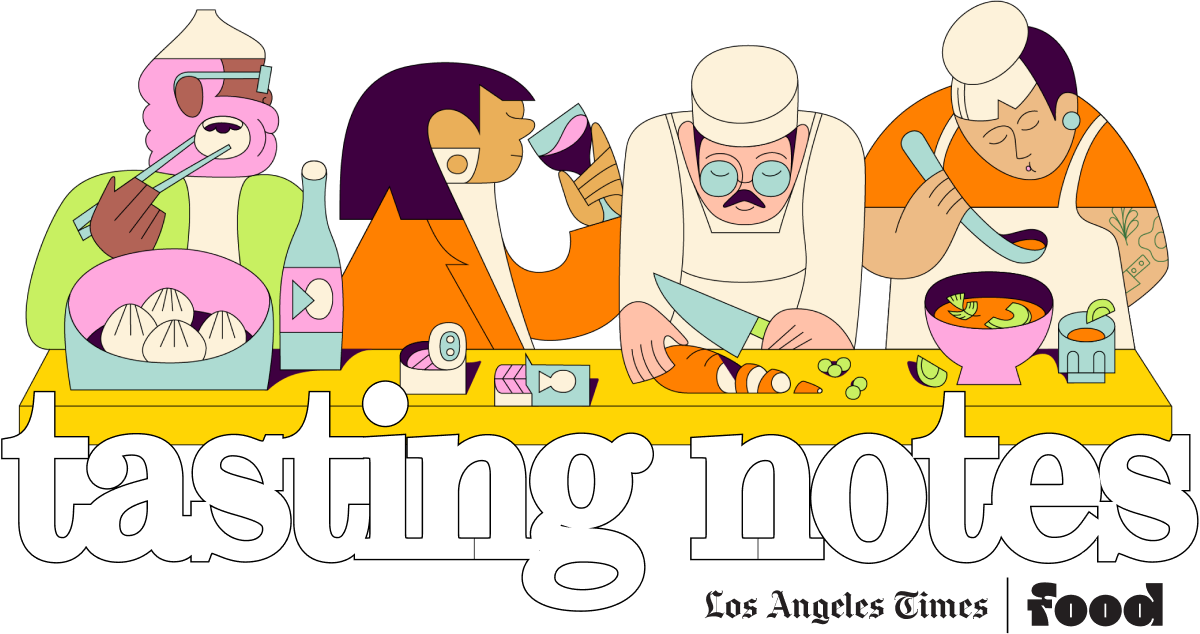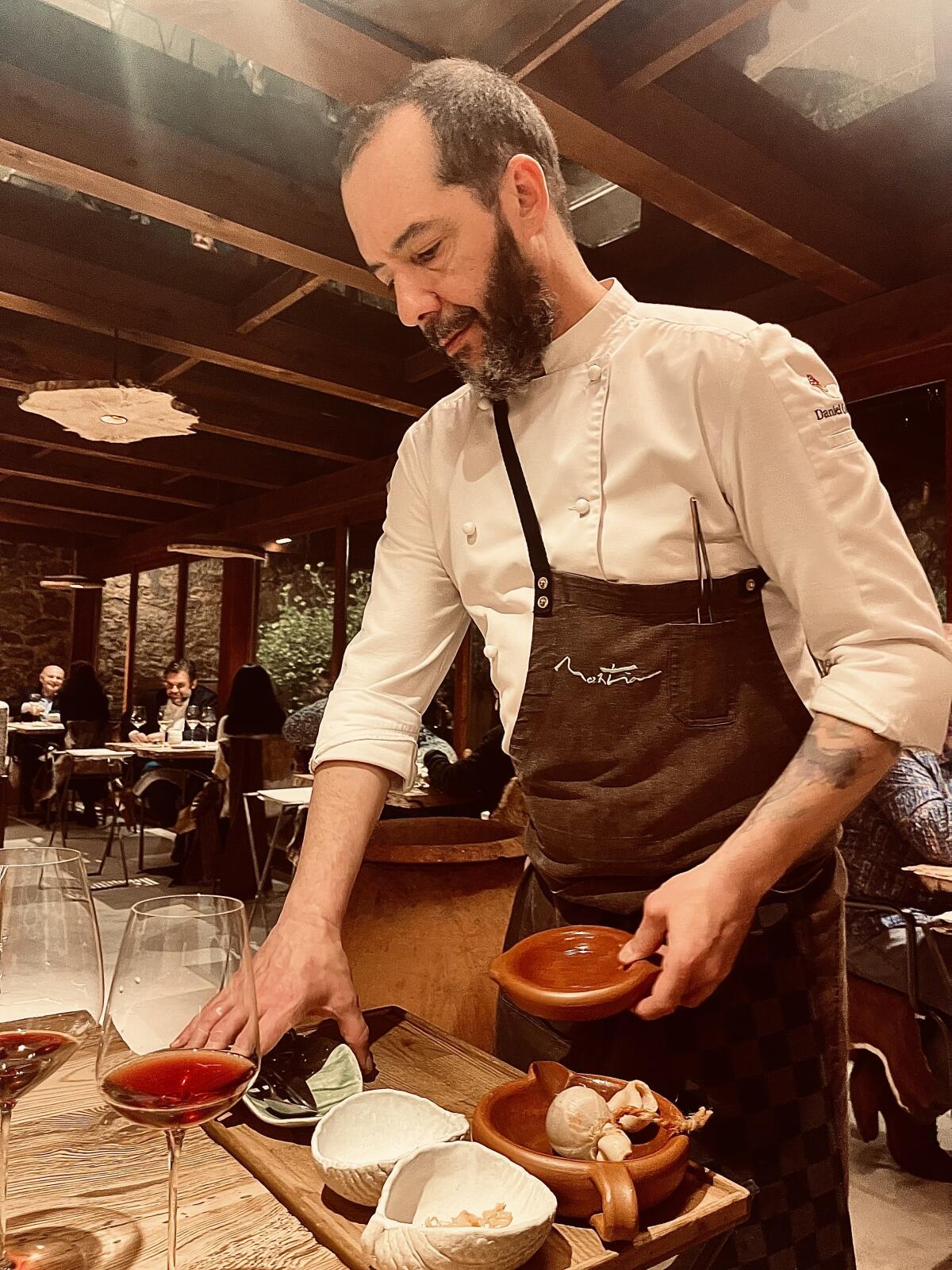What a tripe meatball reveals. Plus, a restaurant for those bored with crudo on every menu, West Hollywood restaurant closures, Genghis Cohen’s last days on Fairfax, James Beard finalists, a Coachella food preview and variations on the Dodger dog. I’m Laurie Ochoa, general manager of L.A. Times Food, with this week’s Tasting Notes.
The callos connection
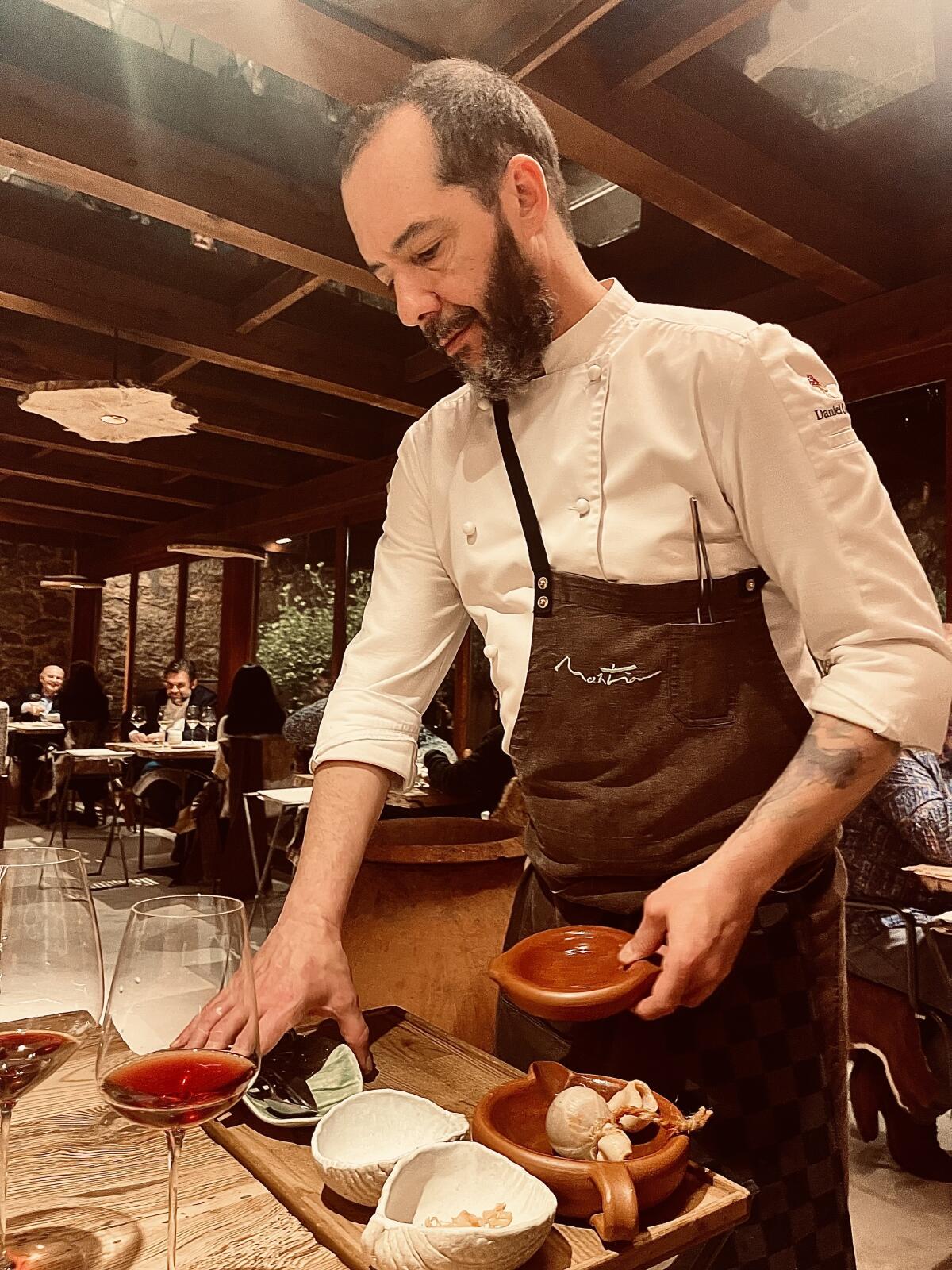
Chef Daniel Ochoa prepares to serve the first of two callos or tripe courses on the tasting menu at his restaurant Montia in outer Madrid.
(Laurie Ochoa / Los Angeles Times)
Chef Daniel Ochoa (no relation) approached my table with a wooden tray balancing a pair of kitchen scissors and an arrangement of clay bowls, including one with a neatly tied ball that I was about to discover contained the best meatball I have ever eaten.
This was the chef’s very personal vision of callos, a reworking of the traditional Spanish tripe dish, often made with morcilla or blood sausage, chorizo and pig’s feet, which help make the sauce especially rich. Where Mexican menudo uses hominy, or nixtamalized corn, callos sometimes includes chickpeas and is more of a stew than a soup.
“It’s the most important dish of the restaurant,” Ochoa told me when I was deciding whether to get the full or abbreviated tasting menu at his Michelin-starred restaurant Montia in San Lorenzo de El Escorial on the hilly outskirts of Madrid. Once I knew callos — served in two courses — was on the full menu, I went all in.
At the table, Ochoa took the scissors and snipped the clean, beige natural casing, which was taut like a balloon. Immediately a beautiful brick-orange sauce seasoned with paprika, rosemary and bay leaves oozed out. He held up the bundle with twine between the blades of his scissors to let all of the sauce drip into the bowl and then with one quick motion, like a magician’s slight-of-hand trick, flipped the tripe-and-morcilla meatball into the bowl. Next he plated the meatball and sauce in a fresh bowl and crowned the dish with a lightly fried, chickpea-flour-dusted circle of lacy book or Bible tripe, the most delicate of the three basic tripe types.
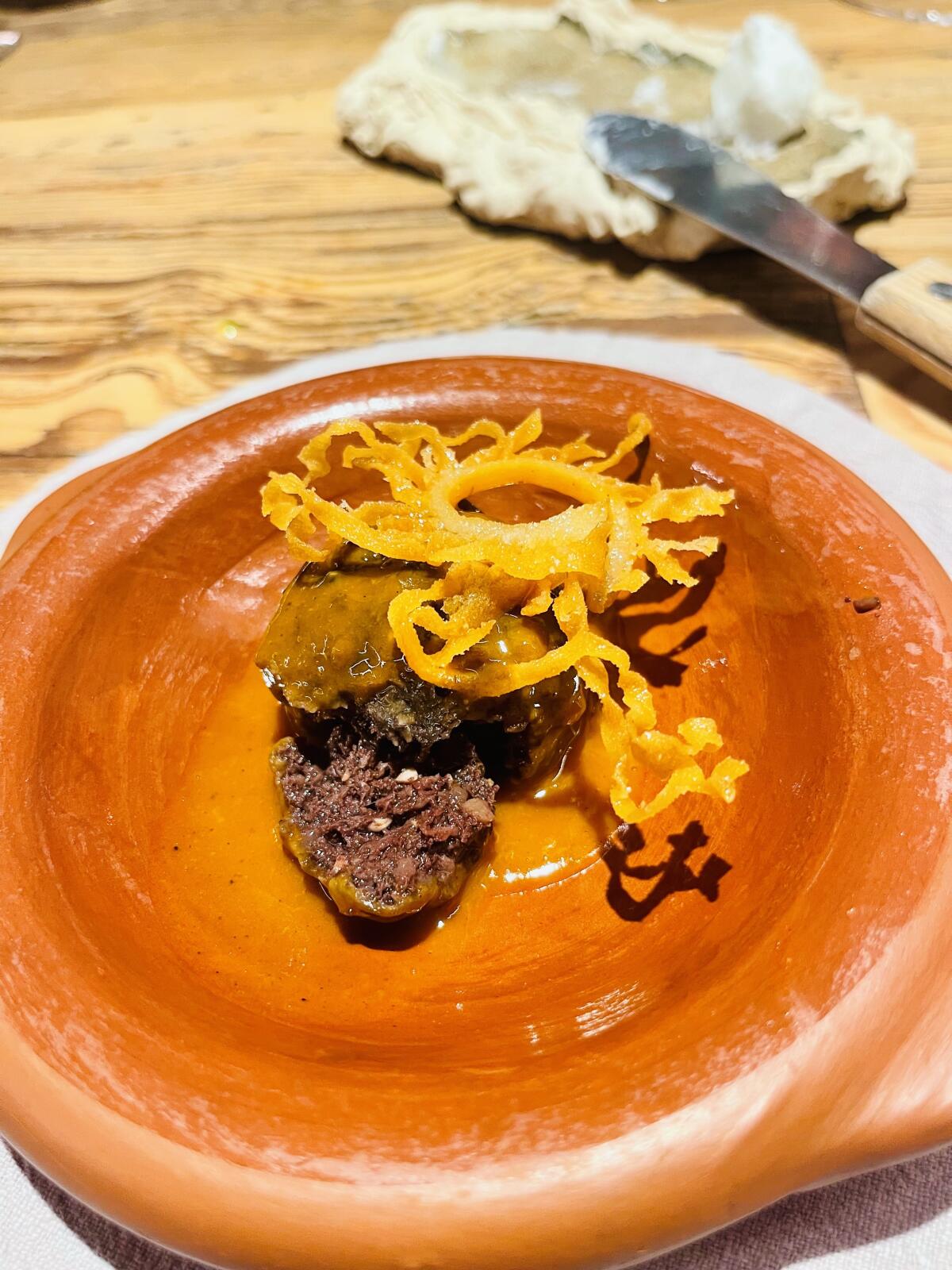
Montia chef Daniel Ochoa’s callos meatball, sliced. It’s made with tripe and blood sausage with fried book tripe resting on the top.
(Laurie Ochoa / Los Angeles Times)
The dish, both funky and sophisticated, was full of rich, rustic flavors that also had an air of elegance. Next came part two of the procession — a more traditional version of callos with delicious stewed squares of tripe and sausage, slightly closer to what you might find in a Madrid bar.
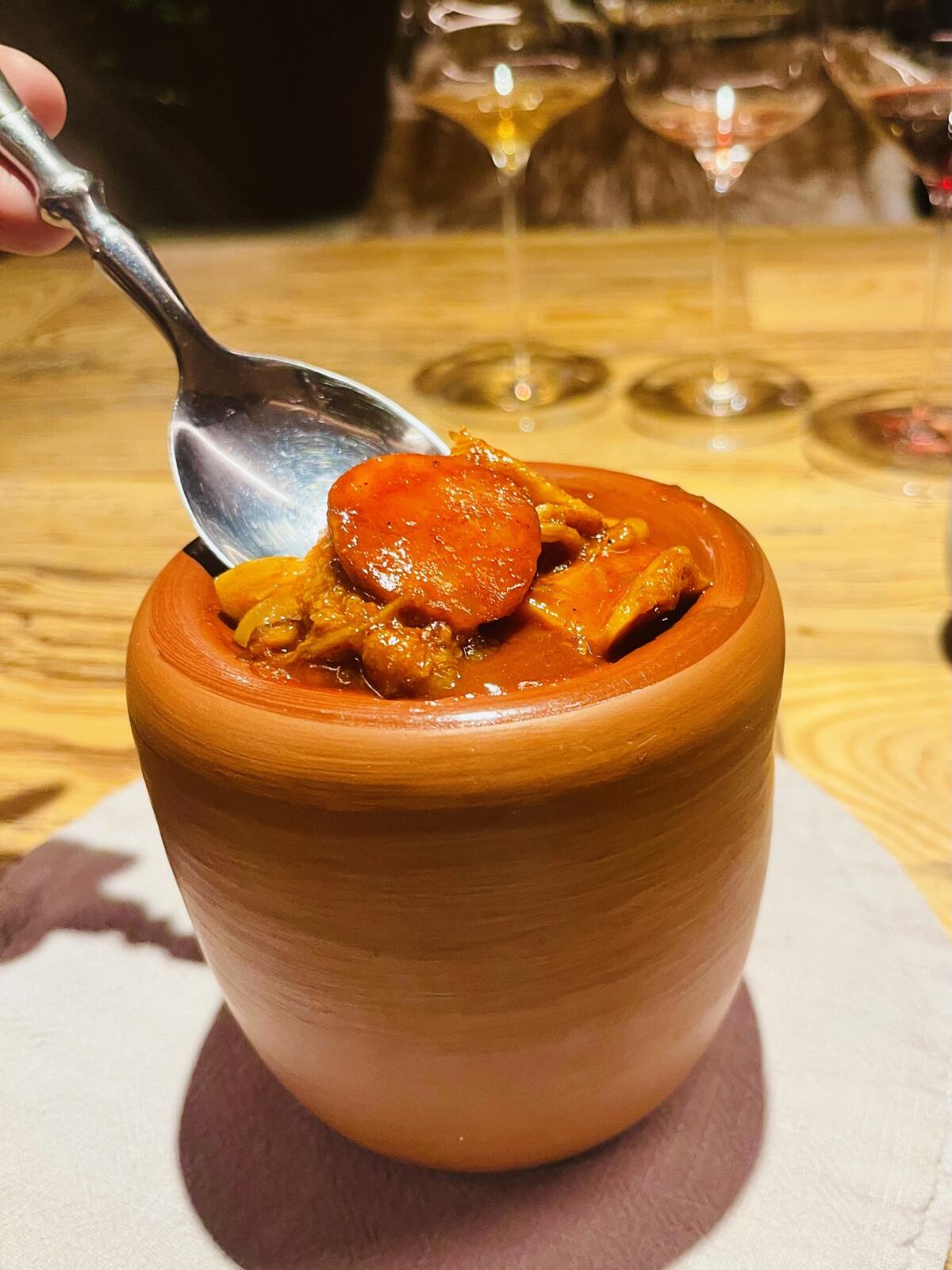
Daniel Ochoa’s second course of callos (tripe stew) at Montia on the outskirts of Madrid.
(Laurie Ochoa / Los Angeles Times)
It was fascinating to find these distant cousins of the menudo I grew up eating during the holidays in a Michelin-starred fine-dining restaurant. The callos seemed to bring together my Spanish, Mexican and Peruvian heritage in a single dish. Making these connections is one of the reasons we travel.
My meal at Montia, during a long-planned trip to Spain, came the week before the world exploded with bewilderment over the extent of the Trump administration’s tariffs. It was an escape that seems especially sweet in retrospect now that stock markets are plunging and airlines are pessimistic about the demand for travel as consumer confidence is rattled.
Always a luxury, travel is one of the first things people forgo when the economy feels uncertain. Yet with each trip I take I acquire new insights not only into the world at large, but also into my own smaller world at home.
In addition to the callos connection, eating at Montia, about a 45-minute Uber ride from central Madrid — think Pasadena to Santa Monica with less traffic — gave me a fresh look at what it means to eat locally. Certainly, California chefs cook with seasonal local produce, but at Ochoa’s restaurant, with a working garden behind the restaurant and the dining room built around two trees that reach through the ceiling, you feel the forest’s influence. The Sierra de Guadarrama mountain range rises above the restaurant’s town, and it’s a good bet that the morel mushrooms surrounded by an escargot broth were harvested nearby. One of his welcome snacks is a wild rabbit croquette.
I was also intrigued by the chef’s treatment of sweetbreads. Instead of serving the nodes whole, where they sometimes look like chicken nuggets, Ochoa slices the sweetbreads horizontally and grills them, almost making them appear like a rare piece of steak.
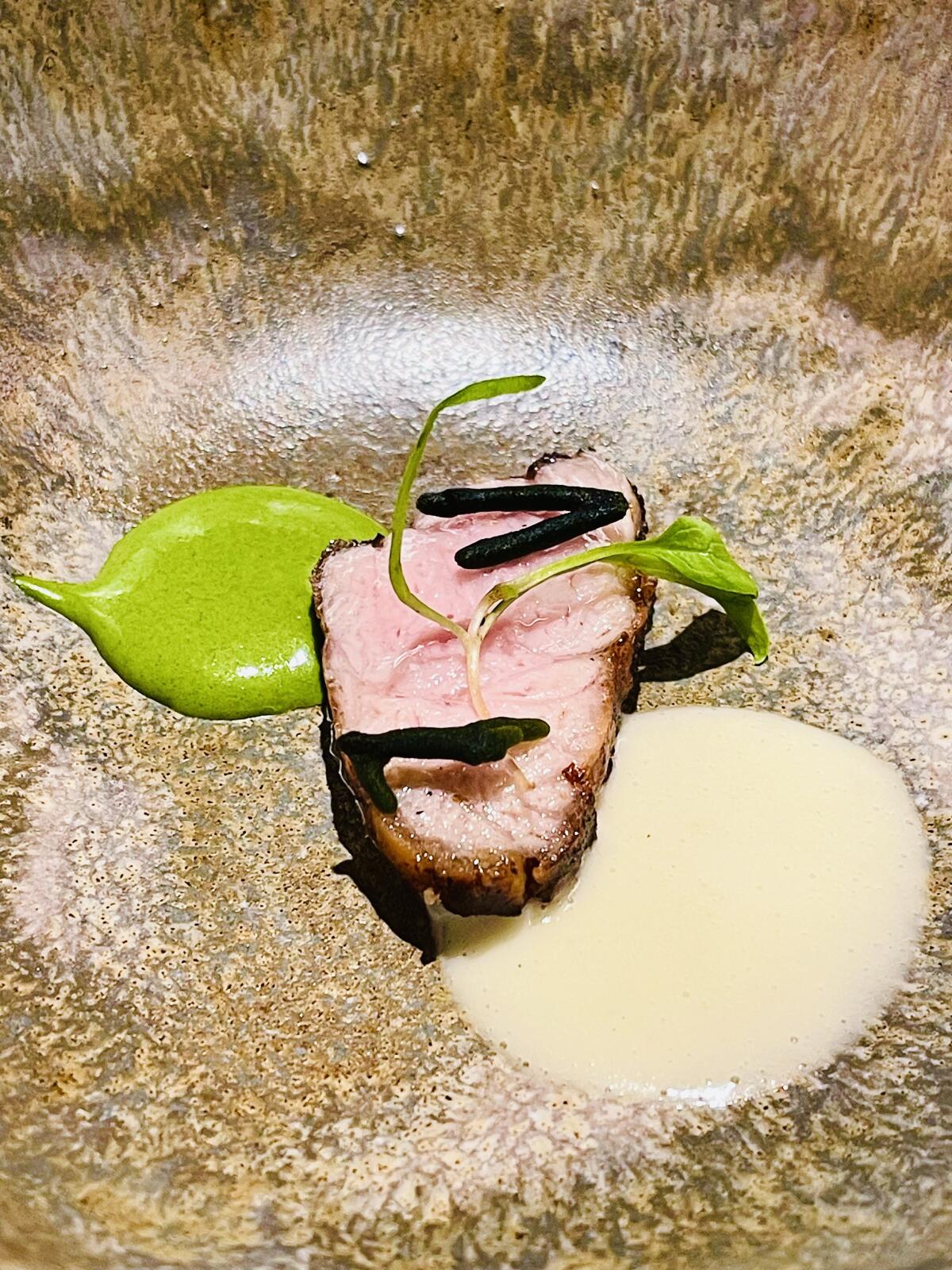
Montia’s sweetbread course, sliced and grilled.
(Laurie Ochoa / Los Angeles Times)
The restaurant’s service was warm and inviting, even for a solo diner, which I was that night. The chefs, their aprons fastened with only a single shoulder strap giving the brigade a pirate spirit, brought out each of the dishes and explained how they were prepared with charm and passion. And it was hard not to fall under the spell of Marco Massolini, the restaurant’s wine guru whose enthusiasm for natural wines is infectious.
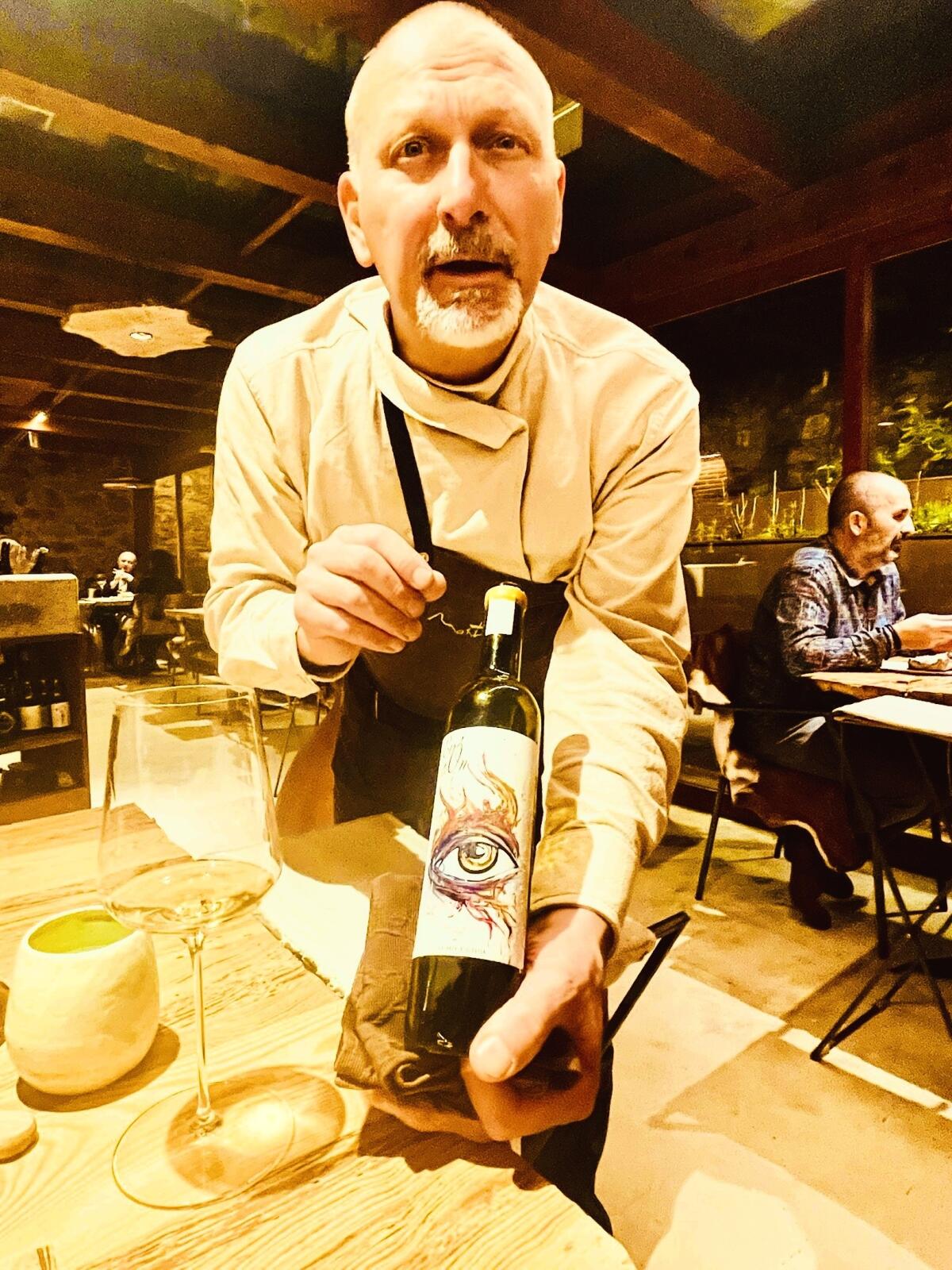
Montia’s sommelier Marco Massolini with a bottle of Evolución 2012, a verdejo wine from Ismael Gozalo’s MicroBio winery.
(Laurie Ochoa / Los Angeles Times)
When the bill came, it was shockingly reasonable compared with Los Angeles tasting menus that can cost more than $300 per person without wine. Montia charged about $250 — 130 euros for some 20 dishes plus 78 euros for an extensive wine pairing. If the tariff situation eases and we feel secure enough to travel again, Montia is a place I’d love to eat again.
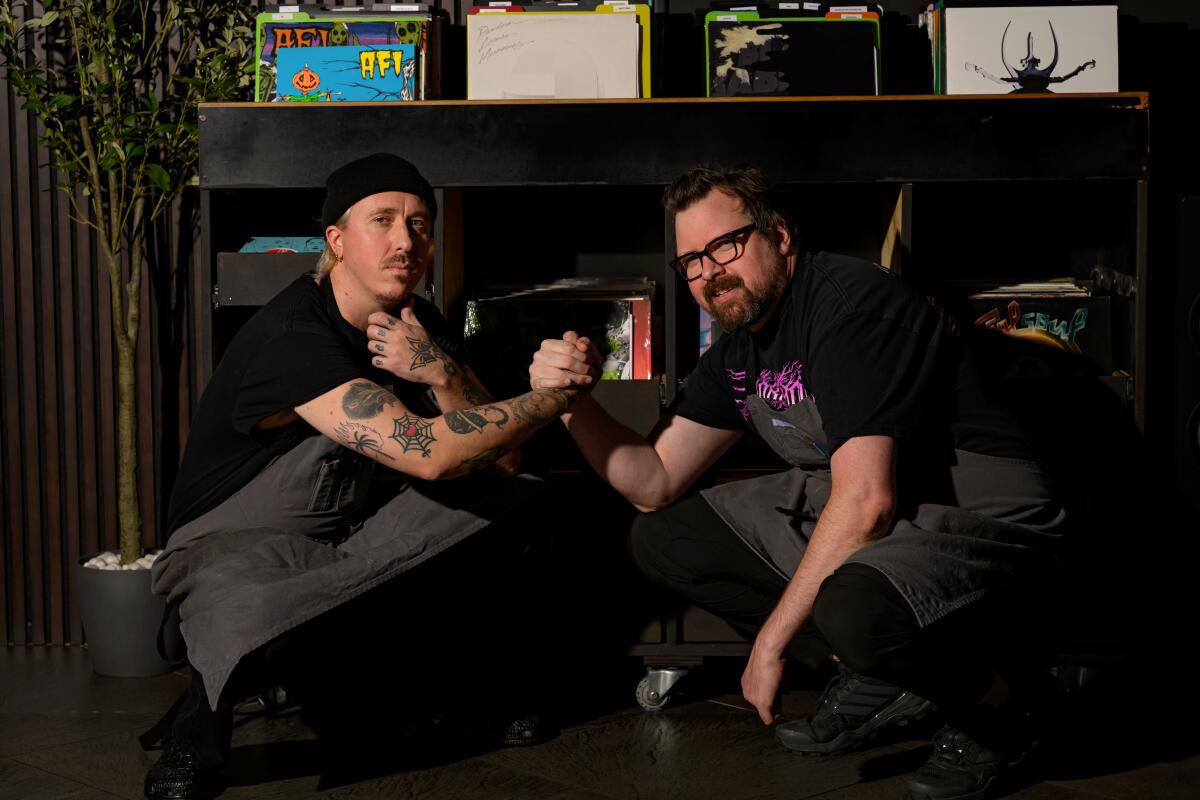
Darkroom chef and owner Zach Scherer, right, with chef and partner Drew Adams at their Santa Ana restaurant.
(Ron De Angelis / For The Times)
Columnist Jenn Harris’ newest restaurant review takes a look at chef Zach Scherer‘s Santa Ana restaurant Darkroom: “Imagine your cool friend from college, the one with really good taste in music, throwing a dinner party where the vibes are consistently immaculate. … The menu is as unpredictable as the music, zigzagging among Asian, Mediterranean and Latin influences before skidding to a stop at dessert. And it likely will change with each visit. … If you’re experiencing menu fatigue, weary of the parkerhouse rolls, gem lettuce salads and crudo at just about every ‘small plates’ restaurant in town, consider Darkroom the antidote.”
Harris also has a separate rundown of nine affordable L.A. lunch spots where a meal costs $15 or less.
Our endangered restaurant scene
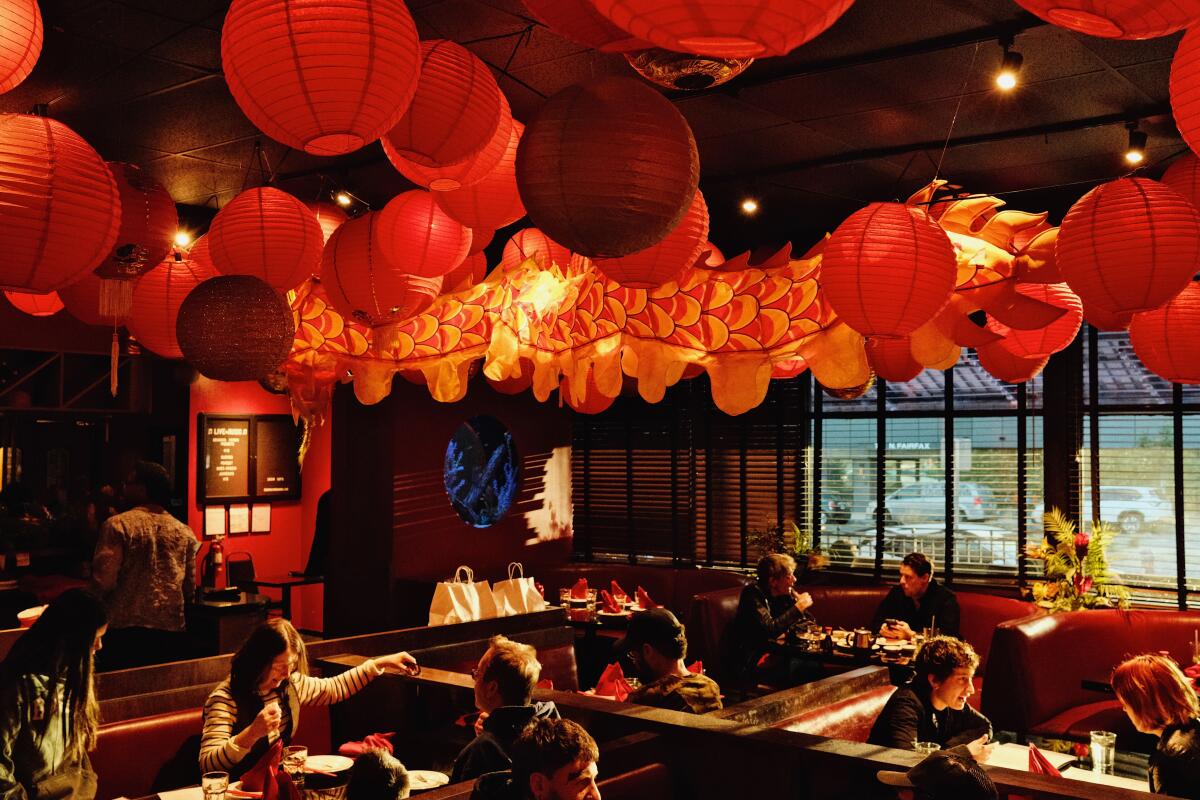
The red lantern-lit dining room of Genghis Cohen in its original location on Fairfax Avenue.
(Stephanie Breijo / Los Angeles Times)
It seemed like Genghis Cohen, with its 1980s-inflected signage and “Kanton Knish” would always be a Fairfax Avenue fixture. But as Stephanie Breijo reports, the New York-style Chinese American restaurant and music venue is under threat now that it’s being forced to move from its strip mall location on May 31 after failing to negotiate an acceptable new lease with the ownership company that is redeveloping the building. Construction has already begun around the restaurant. Current owners Marc Rose and Med Abrous, who took over the business in 2015, “are planning a temporary relocation of the restaurant as they search for a more permanent home,” Breijo writes. They “see the survival of Genghis Cohen as stewarding a bit of the city’s restaurant history.”
“We have been working our tails off to find a solution, and I believe that we found the best possible solution to a real crappy situation that we were put in,” Rose said. “We love this place, we love what we do, and none of that is going away.” Fingers crossed.
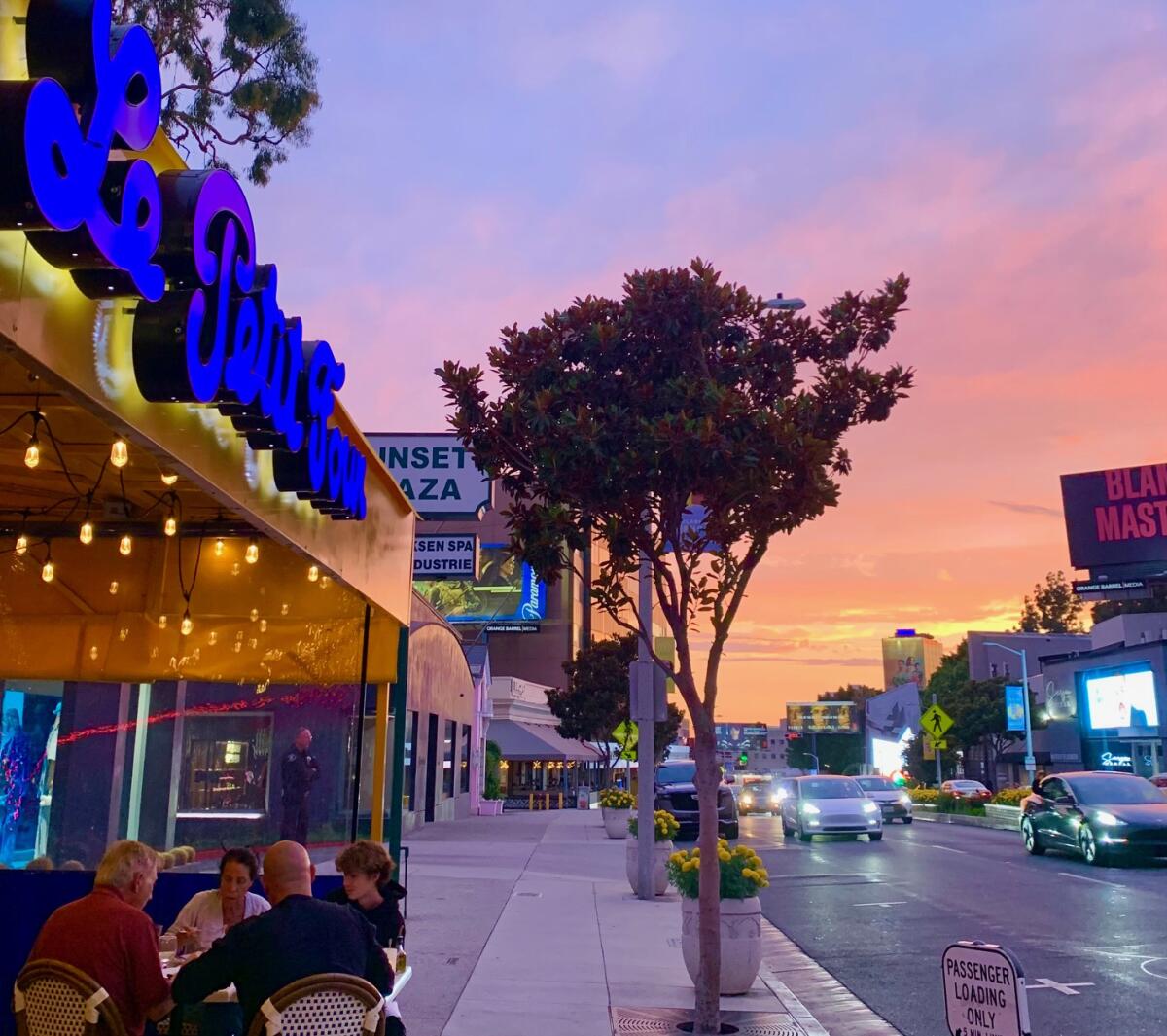
For 44 years, French bistro Le Petit Four anchored the Sunset Plaza in West Hollywood.
(Alexandre Morgenthaler)
Meanwhile, senior food editor Danielle Dorsey writes that “after a swell of community support that ultimately couldn’t save Le Petit Four, the sunny French-Californian bistro in West Hollywood closed [March 31] after 44 years of business.”
“Sunset used to be the place to hang out. It was packed, packed, packed,” owner Alexandre Morgenthaler told Dorsey. “But since COVID everything went up in price. Minimum wage went up 30% in West Hollywood. We lost traffic.”
Two other West Hollywood restaurants, Dorsey reports, have also closed: the Den on Sunset, open for 16 years, and the West Hollywood location of Irish pub chain Rock & Reilly’s.
“In an effort to bring traffic back to the area,” Dorsey adds, “West Hollywood Chamber of Commerce and the city of West Hollywood launched an April initiative that provides free parking across all meters, city lots and city structures every Wednesday from 4 p.m. to midnight. And dozens of restaurants and bars are offering discounts and happy hour deals to encourage patronage, including $10 cocktails and bites at Formosa Cafe and $8 cocktails at Connie & Ted’s.”
One sign of hope: Karen Garcia reports that Norm Langer, who seven months ago told columnist Steve Lopez that he was thinking about closing the 72-year-old Langer’s Deli in part because of city neglect, has seen enough progress in the neighborhood from the Karen Bass administration to stick around — at least for now. Not that everything is perfect, but he sees the effort and hopes to stick around for the 2026 FIFA World Cup, Super Bowl LXl in 2027 and the 2028 Summer Olympics.
Dodger dog frenzy
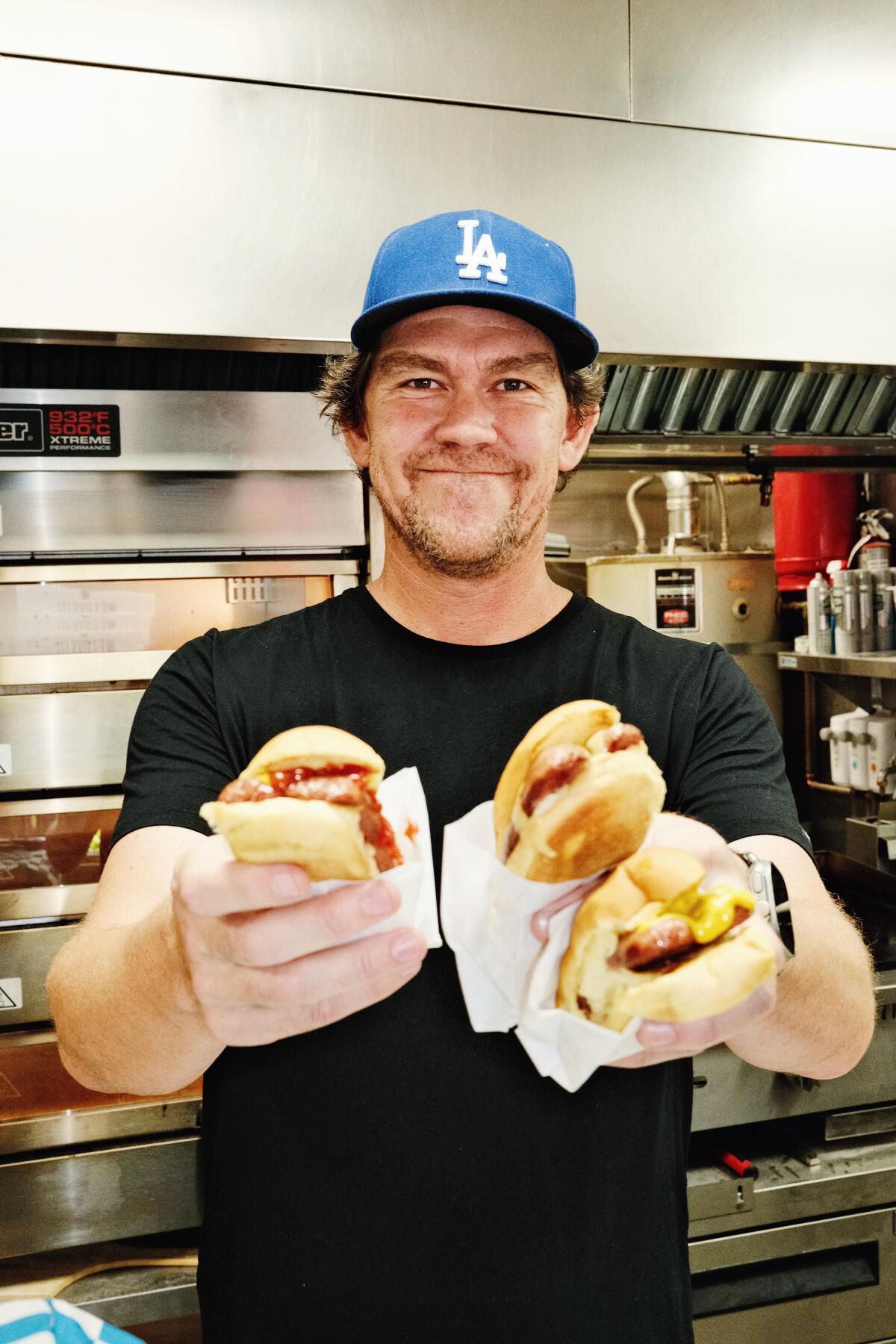
LaSorted’s pizzeria owner Tommy Brockert.
(Stephanie Breijo / Los Angeles Times)
Stephanie Breijo devoted last weekend’s cooking newsletter to variations on the Dodger dog, starting with a conversation with Tommy Brockert of the Dodger-themed La Sorted’s where he offers a Dodger-dog-inspired pizza and will have a rotation of regional hot dogs throughout this year’s baseball season. She also includes recipes for former L.A. Times Test Kitchen director Noelle Carter‘s make-your-own hot dog cart, Marcy Goldman‘s homemade hot dog buns and chef Curtis Stone‘s tomato sauce, a.k.a. ketchup. And sneak peak for next week: Jenn Harris went to Dodger Stadium to rank the best new foods, including the most baroque variation on a Dodger dog yet: the $40 Slugger, a hot dog with a 16-inch jalapeño cheddar sausage so long it needs its own handled cardboard carrying case. Look for her story and video on Monday morning.
Also …
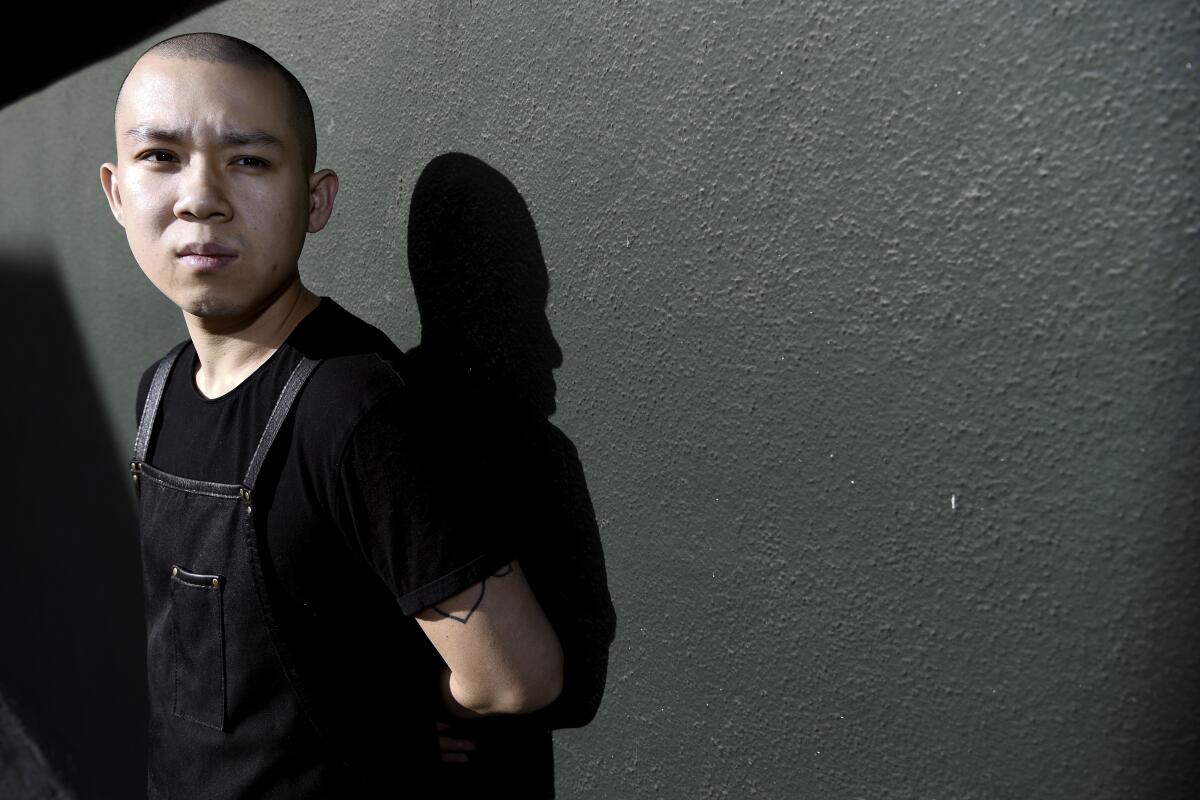
Kato chef and founder Jon Yao is a finalist in the James Beard Award category best chef: California.
(Mariah Tauger / Los Angeles Times)
- More from Breijo, who notes that “nearly 20 L.A.-area restaurants” were represented as James Beard Award semifinalists in January, but after the finalists for the June ceremony were announced this week “only five from L.A. and Orange County will proceed as nominees.” They’re good ones: Jon Yao of Kato, critic Bill Addison and columnist Harris’ No. 1 pick on our most recent 101 Best Restaurants in Los Angeles guide, and Daniel Castillo of San Juan Capistrano’s Heritage Barbecue, a constant presence on our 101 Best list, are competing in the category best chef: California. Arturo Enciso and Ana Belén Salatino‘s Gusto Bread in Long Beach is an outstanding bakery finalist. Robert Adamson and Ying Chang‘s Strong Water, featured in our guide to Southern California’s best tiki bars, made the cut for outstanding wine or other beverages program. And Tobin Shea of chef Neal Fraser‘s Redbird downtown, is a nominee for outstanding professional in cocktail service. Castillo told Breijo of the nomination, “The light has been shown on the amount of work that goes into being able to operate a barbecue restaurant. … You’re working with live fire … you’re working with something that’s wild. … It takes a lot of time to master something like that.”
- Finally, Danielle Dorsey compiled the best places to eat and drink this month, according to our food writers and previewed the speakeasies and food pop-ups that will appear at this month’s Coachella Valley Music and Arts Festival, including a chance to once more eat the food of Diego Argoti, who recently closed his Echo Park restaurant Poltergeist — dubbed by Bill Addison “the most manic, unchecked and wildly envisioned cooking in Los Angeles.”
Newsletter
Eat your way across L.A.
Like what you’re reading? Sign up to get it in your inbox every week.
You may occasionally receive promotional content from the Los Angeles Times.
